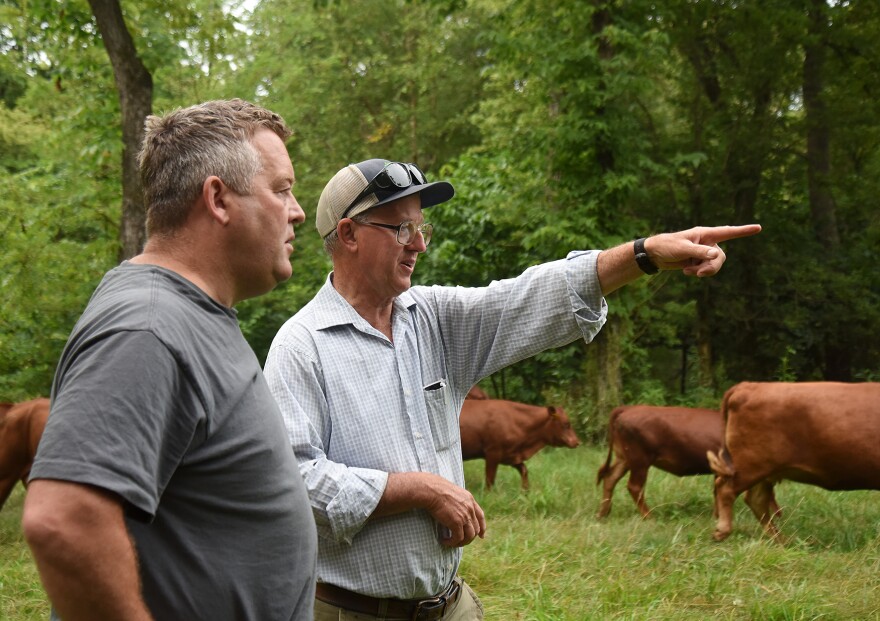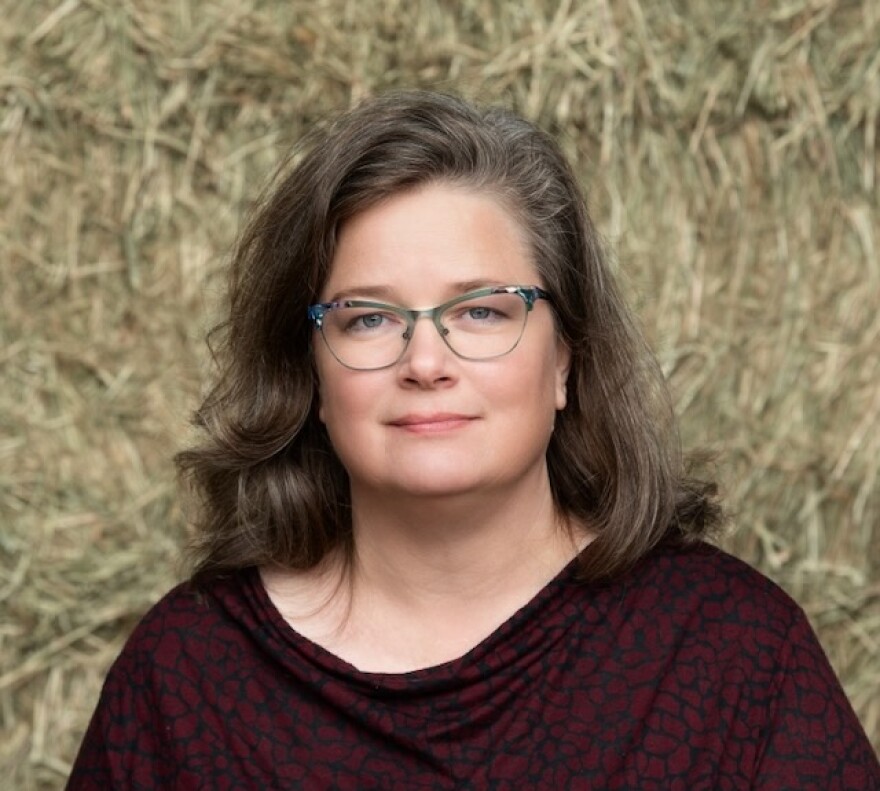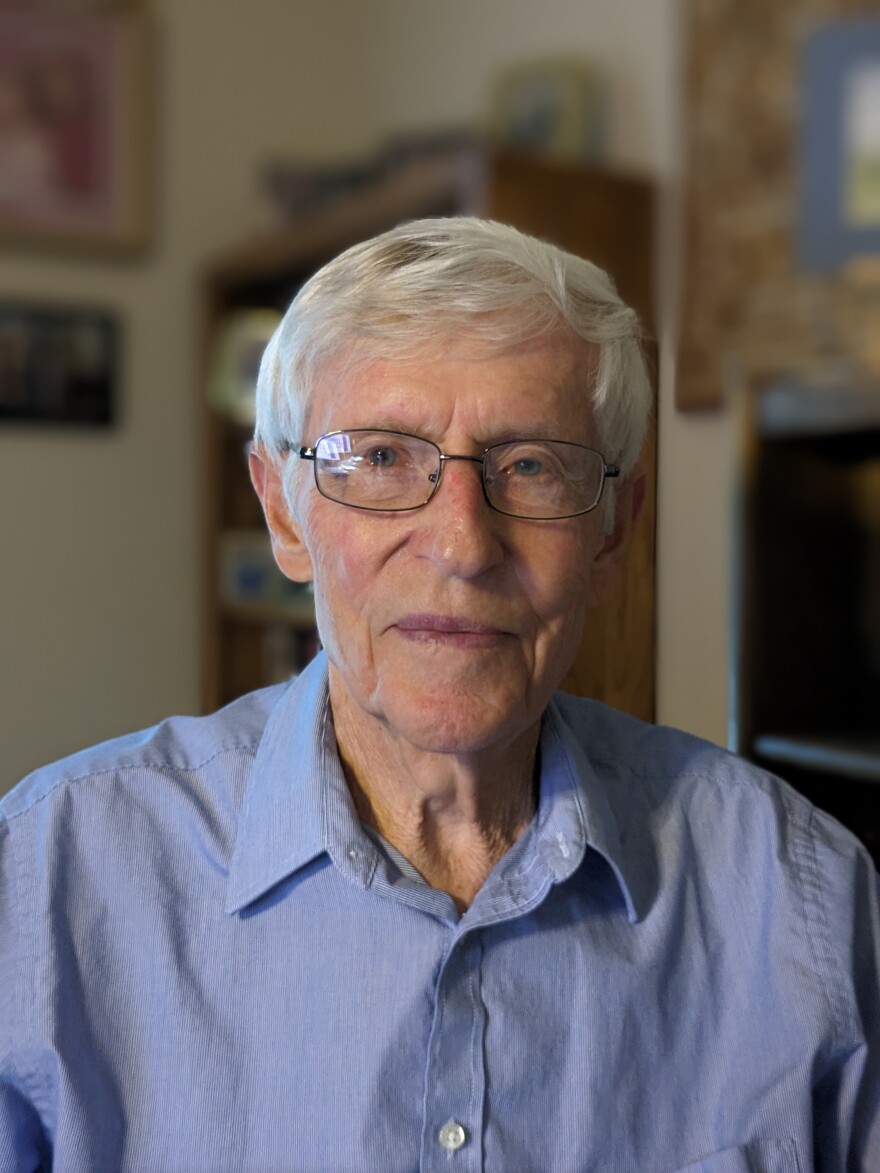At dawn, a few hundred cows followed Greg Judy through a valley to the top of a wooded hill in Clark, Mo.
As the sun rises over northern Boone County, Judy called out to them from an ATV. The slow moving mass of red coats made their way to a two-acre section of pasture where they’ll eat grass along with the hay Judy spreads out for them.
Later that day, they’ll be moved again. This way of grazing cows in concentrated paddocks is a practice of regenerative agriculture. The cattle eat, trample and fertilize the ground as they go.
It’s called mob grazing.
“A lot of manure, a lot of urine and then you're gone,” Judy said.
These ingredients: manure, urine and the work of cattle hooves and snouts, ensure active soil that can ingest fertilizer and regrow grass.
Judy is a leader in the regenerative agriculture movement: farmers who aim to work with nature instead of subdue it. It’s a movement with big goals: to regenerate soil and, by extension, natural ecosystems, farming economies and rural communities. Advocates refer to this as the triple bottom line — the ecological, economic and social regeneration in agriculture.
The U.S. Department of Agriculture has recently invested $3 billion in “climate-smart” agriculture, a broad umbrella including practices like mob grazing. Regenerative agriculture is viewed as a method to not only reduce agriculture’s carbon footprint, but as a potential climate change solution due to its carbon storing abilities.
The USDA is dispatching grants to universities and organizations across the country in an attempt to support environmentally conscious food production.
The ability to produce more food for a growing population, while using less environmentally harmful tools in an era of climate crisis, is a tall order. Making strides toward that goal will depend on farmers in America’s breadbasket. Regenerative agriculture advocates also tout the movement’s ability to save small producers and revitalize rural communities — just through the way food is cultivated. It all starts by rejuvenating the denigrated soil.
Judy puts it more plainly.
“Building good microbial rich soil will grow really good and rich grass, and the good rich grass grows healthy animals,” Judy said.ac
“Healthy animals, healthy people. You are what you eat.”

Finding a new way
Judy is passionate about his work. Wearing thick, round glasses and a red handkerchief around his neck, he delivers bite-sized pieces of wisdom about growing grass, raising cattle and managing a farm.
But the grass wasn’t always green for Judy.
“In 2001, I had $8 in my checking account,” Judy said.
He was going through a divorce, drowning in debt, working a full-time job and struggling to find any profits in farming.
Agriculture has high entry costs. Paying off the land alone can take farmers decades. Then there’s equipment, livestock, fuel, seed, fertilizer and more. Variables like weather and market prices mean farmers deal with a lot of risk.
Judy knew he had to find a better way, and fast. So he began grazing. He stopped growing feed for the herd. Instead, he managed the grass, then set the cows out in a pasture and let them feed themselves. This meant he didn’t need synthetic fertilizer, or large tractors and the diesel fuel they gulp up.
“Building good, microbial rich soil will grow really good and rich grass, and the good rich grass grows healthy animals. Healthy animals, healthy people. You are what you eat.” — Greg Judy
Grazing provided a steady income that allowed Judy to slowly but surely dig himself out of debt. It was eye-opening to Judy: a new way to make a living on the land.
In regenerative agriculture, there is less emphasis on yield. Profit often comes from reducing dependence on what those in agriculture call “inputs” — the materials farmers have to buy to cultivate their product. Additionally, products produced sustainably can often be sold for a premium.
Regenerative agriculture differs from conventional methods due to its emphasis on coexisting with, and even rehabilitating, nature while farming. While answering the call to “feed the world” — conventional farming has focused on productivity and efficiency. Some of that efficiency comes with environmental costs. When a farmer needs less fertilizer, fuel and equipment, it’s better for the environment and their pocketbook.
Regenerative land management practices are not new. They’ve been used by Indigenous communities for centuries. However, regenerative agriculture is now increasingly being seen as a more environmentally friendly way to farm. As the idea takes hold, the funding is following. Public and private organizations are now beginning to prioritize implementing this way of cultivating food.
“There's a reason we call it regenerative agriculture. It is regenerating functional ecosystems. If you actually get the soil back to a biologically functional level, the need for these purchased inputs go away,” Jim Gerrish said. Gerrish is a grazing consultant who taught a three-day grazing school Judy attended.
For Judy, this meant investing in the parts of the farm that can reproduce and regenerate themselves.
“Don't go out here and buy a bunch of heavy metal, because the tractor doesn't kick out a baby calf,” Judy said.
Judy now operates 19 farms and an almost 400-strong herd of his own.
It took years of trial and error for Judy to determine how to best farm with nature. He still changes things as he goes.
Judy recounts his journey to regenerative ranching wasn’t easy. He struggled financially. His neighbors thought he was crazy. But he kept going. In a few years, the farm was sustaining itself and Judy was able to quit his off-farm job.
“I never lost faith in grass.”

Paying it forward
Regenerative agriculture is having a moment. Major food corporations like General Mills and PepsiCo have made commitments to source their ingredients from regenerative farmers. The concept is gaining traction in books and media. Popular documentaries like “Kiss the Ground,” narrated by celebrity climate activist Woody Harrelson, tout its ability to address climate change.
Regenerative agriculture practices keep roots in the ground through cover crops, agroforestry and grazing, which store carbon in the soil.
The science is still unclear about how much carbon and for how long, casting doubt on its ability to take decades of pollution out of the air and put it into the ground. Nevertheless, regenerative agriculture has vast localized environmental benefits for the soil, water and the ecosystems. Many hope it can also revive small family farms and the rural towns they reside in.
Sustainable agriculture was seen as a way forward after the farm crisis of the 1980s. There was also growing consumer awareness of the environmental impacts of agriculture.

This was around the time Jim Gerrish began the University of Missouri's grazing school. Farmers got classroom instruction on how grazing can restore soil and hands-on experience working with cattle.
Gerrish said the folks coming to the grazing school in those years were eager to embrace change. It was an economic necessity.
“We had a lot of people who were desperate for survival,” Gerrish said.
The ability to improve the landscape through farming motivates Judy.
“I want to do my part to make it better than when I found it,” Judy said.
He’s now helping other farmers make the leap to farm in harmony with nature. For years he’s been a mentor, offering a hand to young farmers just starting out.
The best way Judy found to share his decades of expertise?
YouTube.

Judy brings his 105,000 subscribers to the ranch a few times a week via cell phone videos. Viewers can learn how to train a sheep dog or conduct a cattle drive, and they get an inside look at the farm, right down to the earthworms in the soil. Judy is one of many pioneers and mentors in this regenerative agriculture movement. In absence of any formal instruction on how to do this, a grassroots network of support has been built.
Regenerative agriculture is about working within the ecosystem a farm resides in. In that way it is at odds with the standardization the agriculture industry has adopted. For regenerative farmers, it can be difficult to go against the grain.
Sarah Llyod, a rural sociologist and dairy farmer in Wisconsin, said every farm is different, and people can no longer prescribe the same methods across the board.
“He's got to admit that what he's been doing for the last 20 years is not right. That's a tough thing for a man to do. So, humility. You got to be humble. If you're not humble, you're probably not going to change.” — Greg Judy
“The current agricultural system is super locked in to these annual systems — this treadmill of production — where people are just, like, running as fast as they can to keep their enterprises afloat,” Lloyd said.
Judy said he receives daily emails from farmers who need help. Regenerative farmers are looking for guidance and community.
In addition to dishing out advice on YouTube, Judy has written three practical how-to books, started an intern program and a grazing school. All while also traveling around the country sharing his expertise.
Judy is eager to spread the word about regenerative ranching. He knows from his own experience the learning curve from standardized methods of farming is huge. He also understands why some farmers resist.

“He’s got to admit that what he’s been doing for the last 20 years is not right. That’s a tough thing for a man to do. So humility. You got to be humble,” Judy said. “If you’re not humble, you’re probably not going to change.”
Judy found success through regenerative ranching. Like the many other pioneers, he largely went at it alone.
However, that may no longer be the case for farmers looking to adopt regenerative methods. The USDA, public universities and other powers-that-be in agriculture are getting on board. There are a growing number of subsidy programs, carbon markets, training opportunities and workshops aiming to help farmers learn regenerative agriculture.
Growing something more
John Ikerd has cared about sustainable farming for a long time.
“I was born the year after the first farm bill,” Ikerd said.
Ikerd used to think a farm was a business instead of a way of life. He changed his mind during the 1980s farm crisis.

As an agriculture economist and academic, he saw the farming system was not working. Not for the farmer, the environment or the community.
“That was a false promise that we were making to people 50 years ago. We told them that industrialization of agriculture was going to be good for everybody,” Ikerd said.
Ikerd said farmers were told to specialize in one product, standardize their practices and above all else, get bigger. Ikerd said these ambitions led to the mass bankruptcies of the Farm Crisis and began the slow extinction of the family farm. Ikerd and others hope regenerative agriculture can not only restore the health of the soil, but also the health of rural economies and communities.
“If it's truly regenerative, then it has to have the ability to reproduce itself,” Ikerd said. “We have to be able to bring in new generations of farmers to replace the old.”
MU was awarded one of the many USDA grants to implement climate-smart agriculture. The newly created MU Center for Regenerative Agriculture plans to use the $25 million dollars to help 3,000 farmers begin using regenerative agriculture practices on 500,000 acres of land.

The MU Center for Regenerative Agriculture will offer educational programs for participating farmers on each of the practices they could implement in their operation.
“What we really focus on with regenerative ag is not so much the practices, but the outcomes,” said Rob Myers, the director of the Center for Regenerative Agriculture.
The outcomes Myers hopes farmers will see: resilience to changing climate conditions and more extreme weather, healthy soil, biodiversity and long term prosperity for farmers and their communities.
“We are not so much focused on breaking new ground as we are helping farmers,” Myers said.

Regenerative agriculture forebearers like Judy are likely the exception to the rule. Instead of quitting conventional agriculture cold turkey, Myers said many farmers will integrate regenerative practices into their operations gradually.
“We want farmers to look at their systems holistically. And that includes the economic as well as the environmental and quality of life components,” Myers said. “But we also recognize that it's difficult and risky to change everything, right? So for most farmers, their pathway to becoming more sustainable or more regenerative is to change one thing to begin with.”
As a farmer and advocate, Llyod said agriculture needs many more initiatives like this.
“We almost need like this army of people that can be out supporting and assisting people along the pathway that's gonna make sense for their operation,” Lloyd said.
Lloyd said there is financial risk for farmers to change practices. If that change can bring about benefits for the environment, economy and society, she believes people should absorb that risk.
“If we want to see the change…we have to interrupt the systems a bit and give people some off ramps into new systems, and manage their risk of transition,” Lloyd said.
Lloyd said the assumption farmers don't care about the environment is shortsighted. It ignores the lack of economic freedom farmers have and how the current agricultural system doesn’t allow much flexibility. She uses the example of her own farm.
“We are not able to really make a choice day to day on what we're doing, because we're trying to just keep our head above water,” Lloyd said. “Like we're drowning.”
Lloyd said there is also cultural pushback. Farmers who’ve gone against the grain face ridicule. Including a success like Judy.
“All the neighbors around think we're just nuts. They do. They think we're nuts,” Judy said.

Ikerd said it is the public sector’s responsibility to validate these farmers who see the current system as broken.
“You're not some nut just because you think you ought to change farming systems,” Ikerd said.
Gerrish believes regenerative operations can account for the environmental damage agriculture has caused, and then some.
“It is my view that farmers and ranchers have in their hands the best tool for saving the planet and saving our species,” Gerrish said.
Regenerative agriculture advocates and practitioners say the economic and social regeneration — ensuring profitable farms and strong communities — is essential if regenerative agriculture is to be scaled in a way that can mitigate climate change. Regenerative farmers say those big environmental goals can’t be achieved if the social and economic aspects are not also prioritized.
Judy agrees:
“If you can’t make a living on the land, you ain’t gonna change shit. ‘Cause you’re not gonna be there."





